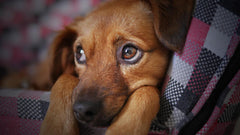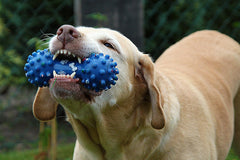
The recall
Gently or almost gently... Basset Hound running across the grass.
Dog educators all agree on this point: recall is, by definition, the criterion of the quality of training or learning. Teaching dog recall is essential for all civilized dogs, whether they are defense dogs, hunting dogs, sled dogs, sports dogs, or just pleasure dogs. The atavism of hunting, the breeding instinct, and also the exhilaration of wide-open spaces encourage a dog in freedom to stay there to enjoy it. Therefore, the first thing to avoid as long as the dog has not assimilated the reminder is to give him the taste of freedom. Keeping a young dog on a lead during walks is, first of all, to protect him from accidents. It is also to teach him to stay close to his master and it is the only way to prevent his innate taste for the great outdoors from developing in him. Cattle farmers know that a cow that has managed to escape will always have the desire to taste freedom again. Like Mr. Seguin's goat. Like all living beings... Walks in the wild must be considered as a truancy, forbidden until the dog has acquired the ability to remember and only offered to him sparingly when he is well educated. I have always regretted one day letting my bouvier des Flandres Narjac undertake a crazy run on one of the immense beaches of the English Channel. To make him come back, I ended up taking my car and leaving. He thought that I was abandoning him and finally ran away... If the quality of the abseiling on a dressage course was not affected, he always remained from this exhilarating adventure the love of the great outdoors and therefore the love of running away. Instilling call-back in a dog means getting him to feel a sense of duty and, even better, the desire to run to his master's feet even if he is busy with a more captivating activity: fighting with a man on the attack, chasing an animal, following a female or simply frolicking? It's a matter of patience and common sense. Some subjects learn faster. Hounds are by nature more recalcitrant than breeds that are close to the master, such as Malinois. But there is no dog resistant to the gentle method outlined below. If you apply it without ever deviating from it, you'll get your dog, no matter how stubborn, to come back to his feet as quickly as he goes.
Do not repeat the order
Walk with your dog in an enclosed area of 1000 to 2000 m2. Set him free. Let him frolic for a minute or two and call him back, just once: "X on his feet! ». The first time, he'll barely pay attention to the call. So walk away from the dog and as soon as he comes back towards you, encourage him without repeating the recall order. Don't mislead your dog about your intentions, to use an expression of the late Léon Destailleurs: the dog must carry out the order as soon as he perceives it. Repeat only if you can doubt that the dog heard you correctly. And in the same tone of voice: don't let the dog imagine that he can wait until you have repeated the order to carry it out or until you have raised your voice... When your dog is close enough to you to realize your good intentions, hand him a piece of meat. Repeat the exercise, first rewarding the dog's approach with encouragement and then rewarding the correct performance with a piece of meat. The piece of meat can be replaced by a ball for some dogs. Problem: if you reward him by throwing him the ball, he may leave with no desire to come back... The ball is still very motivating. The dog brings it back for you to throw it again: it is a proven method to get a quick and happy return.
Rewards
The goal is to get the dog not only to return but to sit at the feet of his master. No need to force him to sit by kicking him on the buttocks: you would give him regrets to the point of partially destroying what you have already obtained. Instead, give him a second piece of meat. With this second reward, don't be in such a hurry. Wait to give it to him until he's done the exercise perfectly, even if you had to help him a little by gently leaning on his hindquarters. The dog's head is pointing towards the reward, which you hold in your hand at hip level. With the other hand, you press down on the dog's rump and he sits gently. Give him the piece of meat. This will encourage the dog to stay close to you when you call him back rather than go out and frolic again. It boils down to this: - One recall command, only one; - One encouragement to the returning dog; - A reward to the dog as soon as he's within your reach; - A second reward a few seconds later when the dog is in position
The recourses
How to express encouragement? Every time you feed your dog or pet him, for example, always say in the same tone: "That's good, that's good! ». Each time you subject your dog to an exercise and as soon as the dog begins to perform it, you will repeat: "That's good! ». Encouraging the dog means letting him know that he is doing what is expected of him. Only when he knows what is expected of him and takes the initiative to do something different should he be reprimanded or corrected. Threatening or slandering the dog when he drags back can only delay the success of the recall training you have undertaken. There are times, I agree, when you have to be patient: when you are convinced that the dog doesn't care about your g... Let's stay calm: there are recourses. A dog, nonchalant on a full stomach, may be a little more attracted to the reward when he is fasting and hungry. When one of his dogs is not close to him, when he "lacks a master" to use the ring jargon, Daniel Debonduwe, one of the best trainers in history, only feeds him from his own pocket... It is a radical recourse, effective with distant or refractory subjects (they are often the same ones): if you leave them without food for 24 hours, they will not be in pain and will be much more motivated by the reward. The lanyard can also be used with refractory subjects. The dog leaps at the end of a tether of about ten meters. Call him back and bring him back to the feet by force. He will understand what you expect of him, but to make him come back quickly, this method should be combined with the reward. And above all, congratulate him when he comes back to make you forgive him for having roughed him up a little. You also have the solution to run after the dog who won't come back and catch him. You will thus acquire a lot of influence over your companion who will never again dare to taunt you. But I think that he is already too fast for you to challenge him... Jean-Yves Réguer Originally written by my friend, Jean-Yves, and translated later on! - Leo Roux



